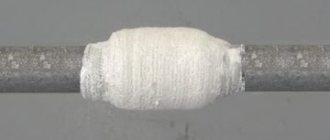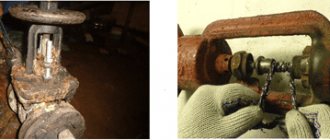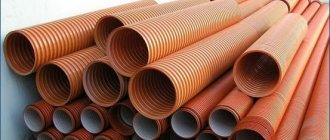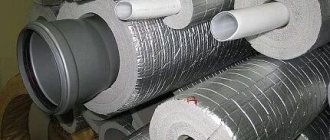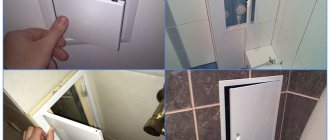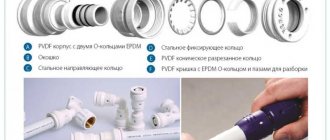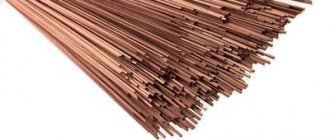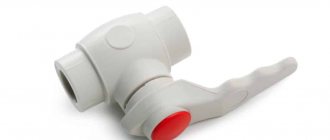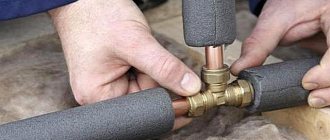Types of basement waterproofing from inside from groundwater: existing varieties
When planning to waterproof the basement and foundation, you should definitely understand its types.
Which type of protection will be preferred depends on the spatial position of the protected base and the degree of exposure to external moisture. We suggest you get acquainted with the main types so that it is easier for you to navigate when choosing the appropriate option. Waterproofing materials come in different types
Depending on the area of work
Before deciding how to waterproof the basement from the inside, you need to decide on the surface to be treated. Protection can be vertical or horizontal. In the first case we are talking about waterproofing the internal walls of the basement, and in the second - the floor. Let's look at both options in more detail.
The spatial orientation of the base is important
Waterproofing the basement floor: important nuances
If the basement is located at the same level as the aquifer, water will inevitably seep into the basement. Properly executed waterproofing of the basement floor, complemented by a protective layer 0.3 m high on the walls, will prevent capillary penetration of moisture into the room. The choice is usually made in favor of rolled materials or filling the floor with polymer compounds.
Rolled materials of various types are actively used to protect the floor.
Waterproofing basement walls from the inside: main types
If waterproofing the basement walls from the inside is required, preference is given to the vertical method. In this case, it is possible to prevent moisture from penetrating from the outside of the building through cracks and joints. Vertical waterproofing of basement walls can be:
- membrane;
- injection;
- coating Performed by applying bitumen mastic;
- plaster formed using polymer compounds;
- in the form of a layer formed using liquid glass or rubber.
Vertical waterproofing prevents penetration of moisture from outside
Depending on the degree of moisture exposure
Depending on the degree of exposure to moisture on the structural elements, waterproofing the garage basement from the inside from groundwater can be:
- anticapillary;
- non-pressure;
- anti-pressure.
Each type has certain functionality that should be taken into account when performing work in a specific room.
To protect against groundwater, you should select a suitable type of waterproofing
Anti-pressure waterproofing
Anti-pressure waterproofing is installed mainly on the outside of the house. It is not suitable for interior work. During the operation of such a protective layer, groundwater practically presses the protective material into the base.
Anti-pressure waterproofing is carried out externally
Anti-capillary waterproofing
With the help of anti-capillary waterproofing, you can prevent the appearance of moisture and dampness inside the basement. With its help, groundwater is prevented from penetrating through the pores present in the material from which the basement is built.
All pores must be clogged
Non-pressure waterproofing
Non-pressure relevant for heavy rainfall and spring floods. The most affordable option is to apply mastic. Waterproofing using liquid rubber will be more expensive.
The use of mastic is important when the groundwater level is high
This is interesting: Cork backing for laminate - material characteristics
Roof chimney insulation
The chimney in a private house exits through a hole in the roof. It requires careful protection. Let's figure out how to waterproof a pipe on a roof. The gaps are sealed with waterproof sealant, but installation of a drainage system and special elements: “apron” and “tie” are also required.
Sealing of the structure is carried out in several stages. First you need to prime the pipe and treat it with bitumen-based mastic. You need to connect a diffuse membrane to it. Now you can move on to making a wooden box. It is installed between the pipe and the roof (more details: “How and with what to seal the gap between the pipe and the roof - different options for different materials”). In this case, the gap should be at least 15 cm. All free niches are filled with non-flammable material, for example, mineral wool.
Installation of the connection to the chimney
To complete the work you need the following:
- Metal scissors;
- External and internal corners;
- Cap with skirt;
- A screwdriver, as well as screws for it;
- SS10 corrugated sheet;
- Hammer;
- Galvanized sheet.
The pipe passage in the roof must be reliably isolated from liquid ingress. High-quality insulation of the chimney pipe on the roof will avoid leaks. The lathing is made so that there is a block in front and on the side of the pipe at a distance of 2 or 3 centimeters, behind it - at a distance of 5-10 centimeters.
An “apron” element will be placed on the front side of the chimney; its width should cover the structure by approximately 10–15 cm. Niches and corners are insulated with sealing tape. Ondulin tape is perfect for this task. Then the “apron” is fixed to the side and nailed to the roof. The junction of the pipe and the apron is secured with a heat-resistant gasket with a clamp.
The junction is installed to ensure reliable waterproofing. The element is made from steel sheet. The junction is installed in the place where there is a profile for the groove. To find out the location of the groove, it is necessary to carry out markings. The work is done using an angle grinder.
Now you can proceed directly to installation. To begin with, a metal sheet is mounted under the lower connection. In the future, it will perform the function of removing moisture. Then the bottom connection is attached on top of the sheet. The first sheet is folded under the second so as to completely line the pipe. The bends must be marked with a marker. Unnecessary structural elements are cut out with metal scissors.
All that remains is to install the side and top connections. The task is performed in the same way as described above. Hems when creating a structure are necessary to protect it from leaking.
Waterproofing a pipe in the ground or outside can increase the life of the pipeline. To carry it out, you need to select the appropriate material and prepare the necessary tools.
Waterproofing materials
It is customary to use film materials as a cutoff, as they are the easiest to install and most effective in operation. There are polyethylene films, membranes with one-way vapor transmission, single- and multi-layer membranes with combined action, etc. There are many options for choosing film materials, the difference between them lies in the area of technical characteristics. The installation and conditions for normal operation are similar.
IMPORTANT!
In addition to film materials, coloring compositions are used, for example, bitumen mastics. Application to the surface is carried out with a hard brush, mop, etc. The advantage of this material is the ability to create a layer of arbitrary thickness. The coating is continuous, without gaps or cracks. This article provides a detailed overview of waterproofing materials.
The disadvantages include the inconvenience of application when insulating the roof from the inside; some brands of mastic require heating to operating temperature, which is difficult in an attic.
Pasting materials are also used, which are stuck to the applied layer of a binder, for example, bitumen mastic. Until recently, this option was the most common, but this method is inconvenient for insulating the under-roof space.
Simplicity, reliability in operation and a huge range have made films and membranes the most widely used. The effect of their use does not change over time, the films are elastic and can withstand slight deformations, which other materials cannot tolerate. Therefore, the most preferable option today is waterproofing films.
Advantages of bitumen mastic
Bitumen mastic for modern pipelines has many useful properties. The main ones are:
- elasticity and fairly high stretchability,
- ability to recover,
- good heat resistance,
- long service life,
- no seams on the coating,
- ease of application.
These features of the mastic ensure high quality waterproofing of pipes, so the material always remains in demand.
Sealing oval and round pipes
Ventilation pipes and a chimney on a corrugated sheet roof can be round in shape and made of galvanized steel. The gap between them and the roof covering is much easier to seal. For these purposes, elastic penetrations are used. They waterproof the junction of the corrugated sheet and the pipe. Penetrations are made for pitched and flat roofs.
Sealing a pipe on a roof made of corrugated sheets is carried out as follows:
- Purchase an elastic penetration of the required size. Then cut its narrow part so that it fits the pipe very tightly.
- Remove the protective umbrella and deflectors from the chimney. Next, you need to stretch the elastic penetration to the very base of the chimney.
- The base of the elastic penetration is attached to the roof using silicone sealant, self-adhesive base or roofing screws.
- At the final stage, a decorative apron is installed on the pipe. It has the shape of a cap and is made to match the color of the roofing material. This element protects the penetration from mechanical damage and exposure to ultraviolet radiation.
To correctly seal a round pipe, it is necessary to choose the correct size of the elastic penetration. If the product does not fit tightly to the chimney, then to create a seal you need to use a sealant and a steel clamp. It should be noted that the penetration may break during installation if its diameter is smaller than the diameter of the pipe.
When removing pipes through the ceiling, ceiling and roof elements, it is very important to remember fire safety. The distance between the pipe and elements protected from fire should be 25 centimeters
Unprotected elements should be located at a distance of 35 centimeters from the pipe.
From this video you will learn how to waterproof a pipe on a roof:
A fireplace or stove heating are indispensable attributes of a country house or country house, which gives them additional comfort, warmth, and coziness. Even with the spread of heating devices powered by natural gas or electricity, they have not become less popular, especially when it comes to the construction of traditional Russian baths. When constructing a fireplace, the most critical and difficult moments are the removal of the chimney through the roof and the waterproofing of the joints between it and the roofing material. In this article we will tell you how high-quality sealing of the chimney outlet affects the durability and reliability of the roof.
Waterproofing the chimney and adjacent roof
Insulating a chimney from moisture is necessary if it is made of galvanized steel, which is easily corroded, or if it is insulated with basalt wool, in order to prevent the formation of condensation in it under the influence of temperature differences.
In the second case, the pipe is wrapped in a similar way to a water supply or heating pipe (a more attractive externally foil material is usually used as a winding).
If it is necessary to insulate an uninsulated galvanized pipe, traditional winding and coating materials will not work here, since they cannot withstand the high temperatures to which the chimney is exposed.
There are special heat-resistant paints specifically for such cases. Using a roller or brush, cover the surface of the pipe with heat-resistant paint in 2-3 layers and make sure that the paint does not peel off over time.
The pipe may need to be repainted after several years of use.
Scheme of waterproofing the passage of a brick chimney
Insulation of a street section of a water supply system: how to insulate a water supply pipe at the entrance to a house
The most problematic area of a plumbing system is where the pipes from outside enter the house. The risk zone also includes laying pipes in unheated basements. During periods of severe frost, the water supply line in these places is most vulnerable.
It is not always possible to bring communications into a warm basement, and therefore the entrance node must be carefully insulated with any heat-insulating material.
In this case, the thickness and reliability of the thermal insulation layer plays an important role. To protect against atmospheric moisture, waterproofing is provided from any waterproof material. The additionally insulated water supply unit is protected with brickwork or concrete.
How to defrost a water pipe: underground, in a private house, on the street Russia is located in a harsh climatic region, so in winter and early spring there is a risk of the water supply and sewerage system defrosting. This is especially true for owners…
Thermal insulation of open areas is more problematic and the question of how to insulate a water pipe above the ground in a country house and in a private house worries many. In this case, there are five possible practical solutions to this problem:
- The use of a thick layer of insulation in combination with a waterproofing casing.
- Application of thermal insulation and heating of the pipe with an electric heating cable.
- Painting the pipeline with heat-resistant paint based on liquid ceramics.
- The “folk way” of laying a water pipe in a plastic sewer pipe and filling the free space with foam.
- Application of thermally insulated water pipes. HDPE plastic pipes with a hard shell of Energoflex insulation and a protective outer layer of durable polymer or a corrugated metal surface are excellent for cold water supply and drinking water supply.
The latter option is ideal for laying new water pipelines and the only drawback of insulated pipes is their high cost.
Types of waterproofing materials
There are many substances that are used to protect against liquids.
Application of polyurethane foam protection
Polyurethane foam
Polyurethane foam is a thick coating applied by spray equipment. The liquid instantly turns into foam in air with rapid expansion. Full expansion is 20-30 times the volume of the original material. In external roofing, as well as other open conditions, polyurethane foam acts as a protective coating for pipes. Polyurethane foam is an excellent coating component for water supply systems.
Methods for insulating external water supply
For thermal insulation of water pipes located on the street, the following are used:
- laying materials of natural origin;
- application of roll coating;
- spraying liquid material onto a previously prepared pipe surface.
Application of simple techniques
Basic techniques are used when laying highways at the boundaries of the freezing zone and depend on the climate zone.
To insulate water supply pipes in a private house, a method of increasing the soil layer can be used, which allows you to remove the boundary of the freezing zone from the main line. A layer of earth or sand is poured along the laying line; in winter, snow can be used.
The width of the soil or snow bank exceeds the depth of the pipes by 2 times. The methods do not require financial costs, but they disturb the appearance of the garden plot.
Types and forms of materials
Insulation of water pipes in a private house using cotton wool is carried out only in dry rooms. To protect the material from moisture in basements, it is necessary to install concrete trays; insulator-coated pipes are covered with a layer of expanded clay. The elements are laid on the pipeline with the edges overlapping by 150-200 mm (to ensure uniform protection). There is pipe insulation made in the form of segments with an angle of 180° or 120°. The parts are laid on the main line; a special lock (protrusion and groove) is used to connect the sections.
The surface is wrapped with a layer of plumbing tape, which holds the insulator and provides protection from external factors. The bends of the highways are closed with standard type shaped elements.
Thermal insulation paint and polyurethane foam spraying
This technology is characterized by the absence of seams and provides protection for highways of complex geometric shapes. Polyurethane foam is applied using a spray; after crystallization, the material provides increased protection against cooling. Application requires the use of special equipment, which increases the cost of the work and does not allow you to insulate the pipes yourself.
Therefore, insulation of the water supply system in a private house is done on your own using special paint, which can be aerosol or liquid (for example, Alfatek materials). Metal pipes are cleaned of traces of corrosion, paint is applied with a spray or paint brush.
The paint contains a binder and ceramic-based additives. The material has a low thermal conductivity coefficient, but a layer of paint may not be sufficient to reliably protect the water supply.
Ready-made integrated solutions
Property owners need to know what else can be used to insulate outdoor water pipes. There are complex solutions that allow you to build a branched pipeline of complex configuration.
Flexible or rigid water lines are available, enclosed in a layer of elastic insulating sheath. There are designs with 2 parallel pipes to simultaneously provide hot and cold water supply.
Insulated plastic pipes are supplied in coils up to 200 m long (depending on the diameter of the pipe, the thickness of the insulating layer and the manufacturer), steel lines are made in the form of straight sections or shaped connectors.
The outer surface is protected by a corrugated plastic cover, which allows bends with a small radius. The plastic pipeline allows the pipeline to be laid without connections, which improves protection against freezing.
How to insulate a water pipe at the entrance to a house
The owner of a dacha built on a strip foundation needs to know how to insulate the water supply pipe at the entrance to the house. To protect the pipe, synthetic and natural materials are used, and heating systems from external heat sources are installed.
If the house is built on the ground floor, located below the freezing level. That insulation is installed directly in the basement. A box is built around the pipeline, wrapped in basalt wool, and filled with sawdust or expanded clay.
Waterproofing underground tanks
Reservoirs located in the ground are subject to the aggressive action of moisture and chemicals that change the structure of the metal. This is especially true for structures located in loamy soils with high groundwater levels. With a larger tank volume, it can practically remain in water for a long time.
In this case, the waterproofing material must also be very resistant to mechanical stress.
For “heavy” waterproofing of such surfaces, two-component mastic is used based on a bitumen primer and rubber additives, and bitumen material with polymer additives “Petroflex”.
When protecting a new metal layer, it is first primed with a bitumen-polymer primer in several layers. Work with the next layer begins after the previous one has dried. Then the surface is coated with bitumen coating.
When working with old coatings, you must first clean them from traces of previous insulation to the metal surface, and remove surface traces of corrosion. Then primer and mastic coating is done.
If the soil is moderately moist without the threat of flooding by high waters, the following scheme can be used:
- The first material is rubber-containing rubber-bitumen mastic, applied in one layer with a thickness of at least two millimeters. Two layers of one millimeter thickness can be applied.
- The second material is “petroflex,” a roll waterproofing and roofing material built on a bitumen-polymer base. Installed in one layer.
Secrets of waterproofing water supply without insulation
Bitumen-polymer mastics have shown high reliability when waterproofing steel pipes. They are used when connecting water mains to a central heating system. Particularly popular among the possible options are “Tekhnonikol” and “Tekhnoprok”. Their main advantage is that they are sold ready-made, in special containers.
The product is applied to the pipe with a brush or roller, forming a high-quality sealed layer that protects the structure from moisture and corrosion. Such methods are used if it is necessary to process long main pipes with a large diameter. Moreover, the benefit of purchasing this option for waterproofing metal pipes is that to obtain a high-quality coating, you can resort to a layer only 1 or 2 mm thick. The only negative is that you cannot work with these products in sub-zero temperatures, especially if the composition is water-based.
Waterproofing materials
For a long time, ordinary tow was used to protect culverts from moisture and leaks. It was wound dry under the thread. During operation, tow fibers quickly became wet, corrosion and mold formed on steel parts, and leaks occurred in pipes.
The service life was slightly increased by the use of tow with painting and soaking in drying oil or red lead. Thanks to modern technologies, the highest quality and most convenient materials have been developed.
PVC tape
The tape is used to protect the outside of the pipe from rust and mold. Most often, polyvinyl chloride tape is used in the construction of a network of pipelines for transporting gas and oil. Leaky areas are also often sealed with tape when repairing heating mains. It can also be used for minor installation of joints of household culverts.
The insulating tape is easily applied by applying glue to one of the sides. Before use, it must be checked for integrity; any even minor cracks or bubbles significantly reduce the waterproofing characteristics.
The material is supplied in rolls, packed in polyethylene, which protects it from external damage.
Rubber sheet
Initially, rubber sheeting was intended for insulation of underground structures. Now it is widely used to protect pipes located in basements and in the ground - in sewer and water supply systems. The fabric also insulates joints in pipelines through which oil and gas are distilled.
The material is durable and therefore has a long service life. It is resistant to salts, alkalis, oils, and alcohols. It is easy to install due to its high elasticity. The rubber sheet retains its waterproofing characteristics under the influence of high temperatures. It does not emit toxic substances into the atmosphere and is safe for humans.
Izol – adhesive waterproofing. The material is highly durable. It is often used to seal metal steel pipes, when interacting with which it easily adheres.
It is resistant to high temperatures (up to 150° C), so it is effectively used in heating systems.
The disadvantage of the material is its instability to active substances that contain solvents and organic compounds.
Izol is highly elastic, so it can be stretched well. The roll packaging in which it is sold is convenient to use.
Heat shrinkable tape
Heat-shrinkable tape is used to waterproof joints that were created after welding all pipeline elements. It is also used in everyday life when working with plastic pipes.
The material has two layers: a polyethylene film and a hot-melt layer. It is applied to a heated surface so it adheres easily. It is not recommended to use it on pipes that have high temperatures. When heated, the material will deteriorate. Heat shrink tape is not used when designing the water supply to a house with a heating element.
The material should not be left in direct sunlight, so it is stored in darkened areas.
Heat-shrinkable polyethylene sleeves
Polyethylene couplings are currently considered the most effective in the field of waterproofing. They are used to protect joints in the pipeline providing hot water supply. Couplings are used when laying culverts, both in the ground and above it.
The material is easy to install. It has highly durable qualities: it is resistant to temperature changes and various aggressive liquids.
Polymer self-adhesive tape
Otherwise, waterproofing tape is called fluoroplastic sealing material. It is used to protect sewer threads from leaking.
The self-adhesive tape is wound overlapping. It can withstand high temperatures, retains its texture for a long time, and is easy to use.
Scope of application of pipeline waterproofing
Today, pipes for any purpose, according to construction standards, must be insulated from the effects of water and moisture. This significantly extends their service life. At the same time, for open systems, the waterproofing coating also serves as an anti-vandal element.
There are three standard areas of water protection:
- Water supply is a multifactorial example, when the choice of specific technology and materials depends on the location of the pipes and their purpose (drinking water supply, supply of process water in production, general pipeline or apartment wiring). Proper treatment allows you to get rid of condensation, hypothermia and the formation of rusty streaks directly in the room.
- Ventilation and air conditioning. In this case, the danger is more caused by external moisture, which can destroy the air duct. For such engineering systems, waterproofing technologies are used with an emphasis on sealing.
- Sewerage. Modern plastic pipes indoors require reliable sealing of joints to prevent leaks, unpleasant odors and the spread of infections. Steel sewer lines must be treated to prevent sewage from leaking into the ground. This is especially true when water supply and sewerage run parallel. If the technology is not followed, the contents of sewage can be sucked into a leaky water pipeline.
A correctly selected sealing method objectively has its advantages:
- minimizing the corrosive effect;
- increasing the service life of pipes;
- obstacle to the formation of fungi, mold, algae and the development of foreign bacteria.
- significant enhancement of the base paint material.
Separately, it is worth mentioning the waterproofing of chimneys and ventilation outlets. The entry of moisture into such structures not only leads to a deterioration in air movement, but also to the destruction of the structure itself.
About thermal and waterproofing of pipes
Scheme of external thermal and waterproofing coating
Let's take a closer look at the external thermal and waterproofing coating of a pipe, based on a layer of rigid polyurethane foam, a steel pipe with a layer of anti-corrosion coating and a waterproofing shell, in accordance with GOST 30732-2001.
The coating includes (see figure):
- Anti-corrosion primer layer, the thickness of which is 120-300 microns. The basis of this layer is an epoxy composition.
- Thermal insulation layer based on rigid polyurethane foam.
- The outer layer, which is:
- Sheath made of polyethylene in the case of a pipeline laid underground;
- Galvanized sheath for external pipeline installation.
- Conductors for the signal system.
- Satellite pipeline.
- Special fireproof insert.
Thermal and waterproofing of pipes is used in the following areas of construction:
- Gas pipelines;
- Oil pipelines;
- Oil product pipelines;
- Condensate pipelines;
- Water pipelines;
- Heating networks, etc.
That is, during the construction of pipelines with channelless underground or above-ground installation at a temperature of the transported medium not exceeding 130°C. In addition, thermal and waterproofing can be used in the construction of pipelines in areas with permafrost.
Example of thermally waterproofed pipes
Complete protection of the joint area is ensured by completing the pipes with the following elements:
- Solvent-free epoxy liquid compositions and compounds;
- Half-shells made of polyurethane foam or rigid polyurethane foam;
- Heat-shrink cuffs equipped with locks.
The service life of the thermal and waterproofing coating ranges from 30-50 years, that is, no less than the design service life of the pipeline itself.
This design significantly reduces heat loss. Thus, in the case when the temperature of the carrier exceeds 100°C, heat loss is less than 2% - a value 10 times less than that of traditional thermal insulation materials.
In addition, the presence of waterproofing prevents pipes from coming into contact with moisture, which avoids rotting and corrosion. Laying such pipes can be done in a ductless manner, significantly reducing the overall cost of the work.
In addition, a heating cable can be installed in the pipeline, which allows inexpensively and effectively maintaining a stable temperature in the transported medium. Heating a separate section of the pipe can also reduce energy consumption.
The heating cable operates according to the following principle:
- As the temperature decreases, the resistance of the heating element decreases, due to which the strength of the current passing through it and the heat transfer increase;
- Increasing the temperature increases the resistance, resulting in reduced heat generation and power consumption.
As a result, the level of heating of the pipe depends on the ambient temperature in a particular area.
Rules for the construction of underground water supply
Basic documents used when developing an underground water supply scheme in a country house or in a residential building:
- SP 31.13330.2012;
- SP 22.13330.2011;
- SP 25.13330.2012.
Basic provisions of regulatory documents
Basic provisions of regulatory documentation:
- When laying pipes, it is necessary to take into account the depth of soil freezing; SP 31.13330.2012 standards recommend laying the pipe in the ground 500 mm lower than the point with a temperature of 0°C. The depth is determined experimentally or according to collected statistics; a calculated determination of the parameter is allowed.
- When calculating the freezing depth, the requirements of SP 22.13330.2011 are taken into account, which stipulate correction factors for various types of soil.
- In mountainous areas or when an estimated freezing depth of more than 2.5 m is obtained, additional calculations are carried out in accordance with Appendix G to the standards SP 25.13330.2012.
- In areas with an average annual stable positive temperature, it is allowed to introduce a correction factor of 1.1, which reduces the depth of laying highways.
Low temperature protection
To reduce the depth of the trench and reduce the cost of work, thermal insulation of pipes is introduced or heating devices from an external heat source are installed. The choice of thermal insulation for water supply pipes or heating method depends on the characteristics of the pumped liquid and climatic conditions.
Sales of pipes with protective coating and insulation services
Antikor Polymer LLC sells pipes with high-quality protective coating directly from the warehouse, and also provides custom insulation services. To create reliable anti-corrosion protection, Polylen 40-LI-45 tape can be used. It is suitable for gas, water and oil pipelines and provides:
- high strength,
- resistance to temperature fluctuations,
- low water absorption rates,
- maintaining protective properties for a long time even when operating pipes in unfavorable environmental conditions.
To take advantage of this advantageous offer, leave a request on the website or call the specified phone number. Specialists will provide detailed information and answer questions about the terms of cooperation.
